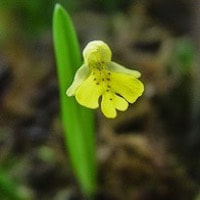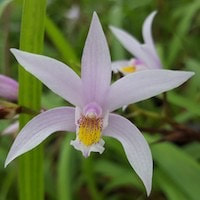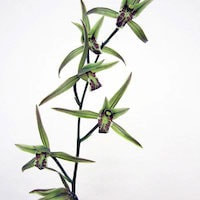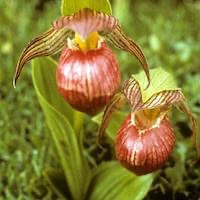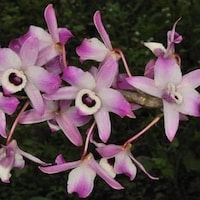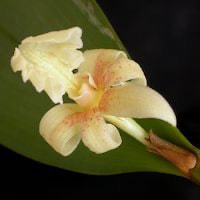MOR10- Men's Oriental 10 - Spice and the city
|
Native Singaporean Orchid notes: Laeliocattleya Twilight Song
Laeliocattleya Twilight Song is a striking orchid hybrid renowned for its large, fragrant blue flowers. Created by Stewart Inc. in 1974 from Cattleya walkeriana and Laelia anceps parent species, it showcases a blend of their best traits. Its blooms feature pale blue or lavender petals with darker-hued lips and intricate veins, making it a favorite among orchid enthusiasts. This orchid's alluring fragrance, reminiscent of blueberry or raspberry, enhances perfume workshops, inspiring participants to create unique scents. Conservation efforts are crucial to safeguard its parent species and other orchids facing threats like habitat loss and illegal collection, ensuring their survival in the wild.
|
Therapeutic Orchid notes:
|
Amitostigma simplex
Amitostigma simplex, commonly called the "yellow flower no pillar orchid," is a delicate and attractive orchid species native to high-altitude regions in western Sichuan and southwestern Yunnan, China. Known for its slender stems and elegant yellow flowers, it thrives at elevations between 2300 to 4400 meters above sea level on cool, grassy slopes. Sadly, this orchid is endangered, listed on the 2006 IUCN Red List due to habitat loss from human activities like agriculture and logging, as well as illegal harvesting. Conservation efforts are crucial to protect its natural habitat, including habitat preservation, restoration, and raising awareness about orchid conservation to ensure the survival of Amitostigma simplex and similar threatened species. |
|
Bletilla formosana
Bletilla formosana, known as Taiwan Baiji or Chinese ground orchid, is a medicinal plant native to Taiwan and East Asia, valued for its therapeutic uses in traditional Chinese medicine and other cultures. This terrestrial orchid features striking purple or white flowers and fleshy rhizomes, thriving in shaded, damp environments like forest floors. In traditional medicine, its stems are used to treat lung conditions, bleeding, and inflammation. Rich in dihydrophenanthrenes like blestriarene B, it exhibits antimicrobial properties effective against bacteria like Staphylococcus aureus and Streptococcus mutans. Despite its medicinal benefits, habitat loss and over-harvesting threaten its survival, necessitating conservation efforts to protect its natural habitats and ensure its continued availability. |
|
Cymbidium kanran Makino
Cymbidium kanran Makino, known as the frigid Cymbidium orchid or winter orchid, is prized in Chinese culture for its beauty and medicinal benefits. Native to East Asia, including China, this orchid features long leaves and tall flower spikes bearing large, colorful blooms with a sweet fragrance. In traditional Chinese medicine, it is used to support heart and lung health, ease coughs, and treat digestive ailments like gastroenteritis. Valued for its cultural symbolism of elegance and integrity, Cymbidium kanran faces threats from habitat loss and over-collection, emphasizing the need for conservation efforts to safeguard its future and cultural heritage. |
|
Cypripedium himalaicum Rolfe
Cypripedium himalaicum Rolfe, also known as the narrow calyx spoon orchid or Gaoshanshao Lan, is a distinctive orchid found in the western Himalayas, Nepal, Bhutan, and Tibet. It features fragrant flowers and broad elliptic leaves, blooming from June to August in Nepal and June to July in China. Used in traditional Chinese and Nepali medicine, it treats ailments such as female infertility, urinary issues, and respiratory conditions. Orchids like Cypripedium himalaicum hold cultural significance for their elegance and symbolic value, facing conservation threats from habitat loss and over-collection, necessitating conservation efforts to protect their future existence and cultural heritage. |
|
Dendrobium nobile Lindl. Syn Dendrobium lindleyanum Griff., D. coerulescens Lindl., D. formosanum Rchb. f.
Dendrobium nobile Lindl., known as the gold hairpin Dendrobium, is a stunning orchid species found across Asia, celebrated for its vibrant flowers and potential medicinal properties. In China, it's called Jinchashihu, while in Japan, it's known as Koki-sekkoku, and in Korea as Go gwi seok gok. The orchid contains compounds like dendroflorin and dendrobine, studied for their antioxidant and mild pain-relieving effects. Used in Chinese medicine, it's believed to benefit stomach health and hydration. Conservation and further scientific study are crucial to preserve and understand its medicinal uses and cultural significance. |
|
Dendrobium plicatile Lindl. syn. Flickingeria fimbriata (Blume) A.D. Hawkes; Dendrobium macraei Lindl.,
Dendrobium plicatile (syn. Flickingeria fimbriata) and Dendrobium macraei are orchids known by various names across India, China, and Sri Lanka, reflecting their regional significance. D. plicatile contains alkaloids and phenanthrenes like lusianthrin and erianthridin, known for their antioxidant and cytotoxic properties. It's used in traditional medicine to treat bile, blood, and phlegm disorders, often in decoctions with similar herbs. D. macraei, also rich in alkaloids and phenanthrenes, lacks specific traditional uses in the provided information. Both orchids' medicinal potential warrants further scientific study despite their historical use in traditional practices. |
Other scent note
Aqua, lotus, Oud, Oak, Musk, Bergamot, green melon, spearmint, berries and peach
Scentopia Library Reference ingredient
Cinnamon - Sir Raffles Collection- Check details at Scentopia's scent library
Download the guided mediation that works best with this Orchid fragrance oil
| men_oriental_essential_oil_orchi_00010.mp3 | |
| File Size: | 115972 kb |
| File Type: | mp3 |

